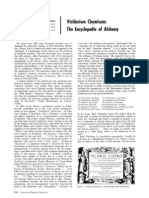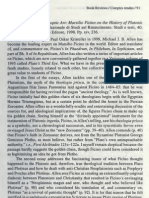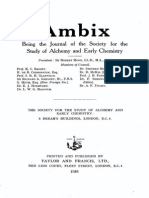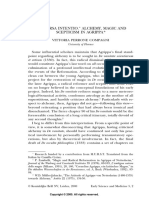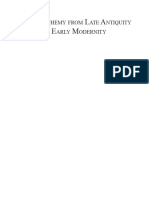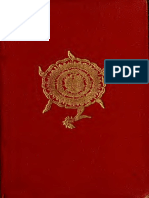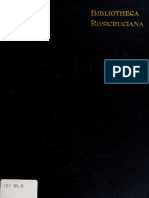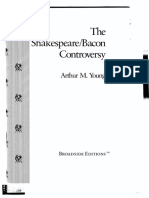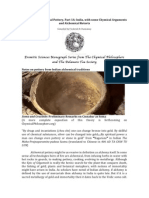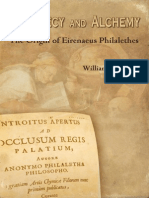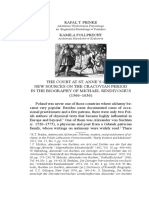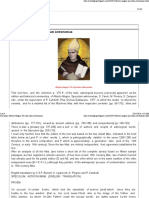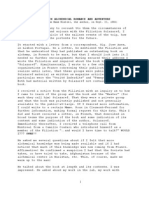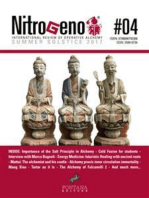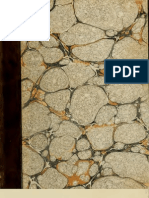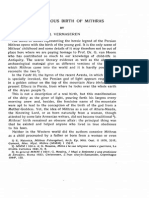Plessner The Turba Philosophorum
Plessner The Turba Philosophorum
Uploaded by
Acca Erma SettemontiCopyright:
Available Formats
Plessner The Turba Philosophorum
Plessner The Turba Philosophorum
Uploaded by
Acca Erma SettemontiOriginal Title
Copyright
Available Formats
Share this document
Did you find this document useful?
Is this content inappropriate?
Copyright:
Available Formats
Plessner The Turba Philosophorum
Plessner The Turba Philosophorum
Uploaded by
Acca Erma SettemontiCopyright:
Available Formats
;2k
rTHE TERRA 1'H11sOI}-(ORt
159
THE
TURBA PHILOSOPHORUM Ri .- FORT ON THREE CAMBRIDGE MSS
Bv M. PLESSNER*
A Pi:ijiR y
ALMOST 30 years have passcd since J . Ruska editcd the Turba Philosophorurn.1 The book had but littie impact on contemporary researcheven taking into consideration the small tuimber of scholars interested in the history of alchemy and the reviews do flot show that anv serious attention vas paid to the resuits 0f his pioncering efforts. E. J . Holmyarcl is practicallv the only writer to have cited Ruska's theses other than by reference 2 ; and there lias ne yer been any adequate criticism of Ruska's treatment of the text and the translation.3 As Ruska's former assistant at the Berlin Forsc/iungs-Inslitutfuer Geschichle der Naurwissenschaflen, which lie had established, I was entrusted to review the book immechiately after its publication. A first fleeting glance at the contents revealed that it would be nece.ssary for me to undertake a very considerable amount of work before being able to make a competent criticism. This I was flot in a position to do up to 1933, whcn I was forced to leave the University of Frankfort-on-Main. Two years later, after I had settled down in Palestine, I was able to study the book, but it took yet another two vears before I finished a comprehensive review 10 1937. The editor of Der Islam, having originally asked me for the review, feit compelled to desist from its publication after November, 1938. Following this, 1 proceeded to revise the whole review and to remake it into an independent paper which I sent to George Sarton for publication in Osiris. By then, World War II had broken out, and the British Censor returned the manuscript. For the moment, I had to leave it at that. I presented the main resuits 0f my examinations in at the annual meeting cf the Jerusalem 1-Iebrew University in me;nor-iam L. Bilhig, the late Lecturer in Arabic, and this paper vas published in a Hebrew version 4 . In 1950, 1 rcad a paper on the advanced resuits of my investigations, to the 6th international Congress for the History of Science, which took place in Amsterdam. Wlicn G. Sarton came to Israel in 1953 to attend the 7th Congress in Jerusalem, lie was prepared to recommend
* The Hebrew University, Jerusalem, Israel. J Ruska: Turbcs Philosoplzoru.rn. Ein Beitrag zur Geschiche der Aichemie.. Berlin, 1931. 'ISIS, XX. pp. 302-305; cf. also his Alchesny. Penguin Books, 1957, p- 8o ff. 'G. Goldschmiclt, Deutsche Litera!urzetung, 1933, 1478-82, extols Ruska's treatmcnt of the text, in words which prove that he was flot sufficiently verscd with the problem of the textual history of the book. Com,nentali,nes I-udaico-Hellenishcae in Memoriam oha,,nis Lewy, 1949, pp. 125-38.
111111 II II III 11111111111111111
0000005595297
16o
Ni. FLESSNIR
the paper for publication in ISIS, and there it was published in the following year. At that tirne, the main resuits of my investigations could be seen in the dating of the text, a staternent on its presurnable author, and the comnientarv on the nine cosniological sermones as an aichemical interpretation of the doctrines of nine pre-Socratic philosophers; the identity 0f three of them had stifi been open for discussion. There were two main points which, so long as no MSS. were available, cause me a certain scientific uneasiness. MN, doubts were oniy too reasonahi particulariy in regard to Ruska's estimate of the MSS. that lie used; and lie wa certainlv incorrect to have renounced the use of ail the other MSS. known to, and described by, him. There is also the fact that Ruska's text of the Turba ends abruptly, and at the saine point as the printed editions, without a proper conclusion, obviously leaving sernw 72 unfinished. I expresscd my uncasines' in my book Pre-SocraUc Philosophy and Greek Alcheniy in Arabo-LaUn Tradition, which will shortly be published, not knowing that before its publication I would have an opportunity to examine some of the nianuscripts which Ruska had disregarded. In 1954, 1 attended the 23rd International Congress of Orientalists at Cambridge. 0f the MSS. that Ruska iisted, but neglected, there are no less than three6 in three Cambridge libraries. I took advantage of my stay at Cambridge and examined them 7. The findings were highly surprising: ail the three MSS. were found to offer the continuation of sermo 72 which I had helieved incomplete. A number of additional Turba-speeches followed and, moreover, the latter were identical in ail the three manuscripts. This was especialiy significant, since each of the three MSS. were independent of each other. It was only after I had surveveci them that I became aware of the tact that flot ail the MSS. used by Ruska terminate where his edited text breaks off, but that the oid prints of version "A" influenced his conclusion. At the present state of affairs, it is too early to edit the new texts: before doing this, it would be necessary to make a further examination of ail the known manuscripts, without regard as tu whethcr Ruska ever saw or used them. In that wav a reliahie text of the new passages could be gained. The following remarks are inteiided to provide a preliminary survey of the extent, the contents, and the character of the new texts. That the printed version "A" was not arbitrarily shortencd by the editor of that time, is proved by anothcr MS. (Oxford, Corpus Christi College xz),
'ISIS, XLV, 1954, pp. 331-338. Ruska, op, ci!., pp. Sa-Si. ' I wish to record herc my gratef ut thanks ta the Librarian of St. John's, for kindly allowing me ta examine the MS. entrusted ta his custody, though the library was closed at that time.
'cf.
THE IU RHA I'HILOSOPHORUM
161
which Ruska haci known as well 8 , and which I had also examined in 1954. This rnanuscript does, in tact, end at the very point where version "A" breaks off. The three Cambridge MSS. are: i. St. John's College, No. 182 of the printed catalogue, press-mark G.14, dated 10 December, 1479; 2. Trinity Coilege, No. 1122 of the printed catalogue, press-mark 0. 2. 18, undated, and believed hy the cataloguer to be of the 14th or I5th century; 3. University Library, No. 1255 of the printed catalogue, press-mark H. IV.12, 13, dated 16 January, 1529. Ruska devoted one and a hait pages of lis book to a discussion of the St. John's manuscript. The major part of the discussion consists of a print of tue Incipit and the Explicit of the manuscript. Apparently lie only used photographs of the beginning and the end of the text, and neither saw the MS. itself, nor inqiaired after it, but reiied on the printed catalogue. However, the MS. was folioed twice, and Ruska obviously used one kind of paging for the Incipit and the other one for the Explicit. Hence lie came to the conclusion that the MS. consisted of no more thari 25 small folios comprising but thirteen sermones at the utmost, i.e. slightly more than one sixth of the whole book. The text of the Turba, as presented by this MS., actually fills no less than 121 foliosfive times as much as Ruska had believed. And since the beginning and the end of both the Cher Cambridge manuscripts are identical with the beginning and the end of the one and only manuscriptMS. St. J ohn'sthat Ruska examined more closely, lie concluded that the former manuscripts were just as fragrnentary, and left them unexamined. The Trinity College MS. lias, in fact, i folios in a very small script, and the University Library MS. lias almost 70 folios'. Since the rnanuscripts originated in between the 14th and 16th centuries, and are considerably longer than the printed version and Ruska's edition, it becomes necessary to collate them in order to flnd out in what manner they offer new or better readings than Ruska's edited text. I would, however, suggest that ail tue MSS., whether used, or Ieft unused by Ruska 10 , should be collated, in view of the fact that, in numerous instances, Ruska's readings are disputable. In order to corne to this conclusion, one lias but to look up the Arabic original, or to reconstruct it where not extant. Even Ruska's reading of the text of the manuscripts, upon which he based his edition, is not fully incontestable, as can be seen from the facsimile page of MS. Berlin in his book." None of the ahove remarks are, however, meant to depreciate Ruska's extraordinarily courageous and fertile endeavours; they merely serve to remove the
$ Ruska, 0f'. Cit., P . 75 f. As early as 1857, the author of the printed catalogue rcmarks: "This Liber Turbe corresponds very nearly with that printed by Mangetus, and with that in the Theatrum Chemicum, AS FAR AS THEy co, BUT IS LONGER HY 9 CHAPTERS; and the concluding chapter in the edition "Philosophus inquit" IS SHORTER THAN IN THE PRESENT MS." Cf. the chapter 'Die handschriftliche Ueberlieferung" in his book, pp. 69-94. ' For particulars, sec my forthcoming study.
162
M. PLESSNER
erroneous conception that the phiological work on tliis text has been cornpleted. On the whole, there are seven or eight 12 new Turba-speeches which provide a total of 79 sermones. Whether ail of them are part of the original Turba, is more than doubtful. Sermo 72 of the "Philosopher" is followed by that of Pictagoras (ioiv.the numbers refer to the St. John's MS.); then conic sernw 74 of Arisleus (I03r.), the same person who was ordered by Pythagor, to cali flue a.ssembl y of philosophers; Arisleus's is followed by No. 75, the ser of Leucippus (107r.), and lue is foilowed by Democrites, serino 76 (1r4'(.). The sequence of orators with Greek names then ends. They are followcd by two orators with Arabie naines, i.e. No. 77, Albemazar (ii), and No. 77a, Abebecar (ri6v.). I refer to tue speech of Ahebecar as No. 77a, because in the MSS. it does flot form the beginning of a new paragraph; nor does his picture appear in the margin of St. John's, which dcpicts ail the other orators. It is uncertain wiietlier Fie is quoted hy his predecessor, Albemazar, or whether lie is an orator in bis own right at the assembiy. In any case, lus sermon bears a number like those of ail the other orators, and the number appears in the margin of the MS. The last two orators are flot even Arahs; number 78 1S the sermo of Marcus Rex Grecorum (ii8r.), and number 79 is that of Arthurus (I2or), i.e. King Arthur. To what extent the new sermons are part and parcel of the original Arabie text of the Turba, is, as vet, not clear. Since the edited text contains none but classical narnes, Democrites is likely to have been the last of the orators whose speeches formed a part of the original Arabie version. 1f 50, the foliowing three or four sermons were certainly aclded hy the Latin translator, or even aftcr his time; however, this cannot he verified until the text is thoroughly examined with a view to the elucidation 0f its contents, and the style in which it is written. The sermon of the Philosopher, after the end of the text in Ruska's edition13, continues as foliows: "Hoc scitote quod omnis lapis apparet rnortuus, igne tamen factus est viscosus It appears that the character of Pictagoras' sermon does not differ at ail from that of the aichemical Turba-speeches. At the end, lie asks Arisleus to expiain his doctrines to the assemhly in an easily understandahle manner. Arisieus now procecds with Fis sermon, which is also preserved outside the framework of the Turba, and is separately edited b y Ruska in the iast part of 12 The author of the catalogue of the University Library, Cambridge, in mentioning g. overlooks the fact that the speeches in the MS., from the beginning, are counted differently to Manget's and reach as far as No. Si and that, on the other hand, the Philosopher's speech has the nimber 73, and flot 72. P- 170.
iuti.t vl1t i
lriti in iunicwwi 1T1I
101 1111 A
ut. nq
a t4 i-wt t't
Vtl'ti Ct' tiC1lL 141lYllit.CL C\'O [ t i tiL i'ttnb; .
t1%I:t 1IY1t t titiT
l t(l, CVt3lldth
cqIi.inir
II(L 4P t tt 1 '-r - )-LhL'; J LlIL 3fl1) 1t ni
11it1itntit
i
'-'e vrvilli It(_-utt\1--r ini1i3
tL't%: L'
4.
ltf't t}f'1TD fl1tI tl11i! 1311i' -tii I1 titttt 11 %tfuFtL . 1ltt2 L)/
"ttttc irnhi LL44IlI1t. I
IlLt, 1. i(_j)I(dLIc:d 1\ h'Iiii - ,iici:ridg- \l- 4,
I1!L
JN
,
1\ tL jitq 'Ur
.1 ' 11h11V trUt :fft
!
tunt, F: .t F1li
tt-L
ttit \7t 1t%tt qi lui 111fhv 1 fin . . tltt h%LUtt t%11%?
n q
ef 1iifl t iT
Lii71l'3 1u ilii 1 (ii : nitit%' tltFzLiIt i. ttt:t
L %tt
1t
CVL' LLTt'JIq
ftt r ,1tntT-?L %'fls-fli--Tt
L,d'tt - 1ttnt.\'u nibttt
c,t)Xt%t1Ii tV t 11111mr, fil,
I Lit.- II
%itl, tititflt
ltu%: i,1ttrstL
Ir -. -, I -i- L t. L I I I.
L L1IIj.
I_ I.T'. _
r -. iM 1 4 1 k' Ii c jzrt 't*iI fut)+
tntfflf * c1ni
1 I11 ,AD W'iiit- oiii c- 'jn, nio4tQ
m Ca
,jIfi4,t il,
tf tio.iit9. t3 flrn t ti7%ni cfiI1 znc6f1 fJflIGi tst 4rflDlU6' njatOc4 .4*1&1I tiiu r n 'g'i,'n 47 i1l nif tti t( 'ts ,i,4' c 4 tt ici-'t4c It Ti 1'?' i1ti-Jo f$rn'd fh( *acs j'hi
^rp^^j
mis
C1fl e,,. 11t,h1
1t?t4'$2JtJ 4' -c t ffri1 4f4 J,t4t!1 n tv Itx,t*u 4,tftt no4 i, 1I D,,c1 4*.'i iibf tcc'
$l Ii 4r
mniLq 4pf fille
iif tt g ncw fcl hafrtlf'
Y%%
4tt . .n,t tft i f;iwi b-W' t1'Ic-1tt ?IP
iiii i,tntO'
IIIl tL.vcm1 ff rrS-*tT,ctq4ijg N"'
I411siiwiI.
t
r& 4Ilt5
1f;j PS g1111 ,1t(en &IO
crts
"r
tp $fl&1t ri,Jt'ui ofl' fl 1t CC1k cni I 16"VI* 'IL ifl1' it 1fl ttwcc ' M6'nioi. ,lt 1w L. R inqhfl4t*. tt4tt- t . 'V1 J r'' mi1t&t3iktt. ii
tti*n. it' flt;r-fi jiEtt c.'ict *1,4e now iblit itoit ni nCi-in t' pi& 4iift -- rt1t 1 i iti r4(I -tf c 11014 oiI +t %i1 t ii ,- cQt tt fl4c-c- - % cttitit ji i g tIC.q v d %-tij
cC?tfl-.j tttU'-
iii iitt
fh,'i
J7
ilcre
mt'qt.
-Itil tteoItc cbi)ii,
t b'ii' .;.. .t -
74c p't
Plat- III. lI-)t&ItICtcl bv
cuuiteiv f
Tti llity 11 - 1 - Or.
( 11e,-e (tiiltrkIge. froiii MS. O. 2. 18,
perfl fia c'
z
j3
- pfl, ? e7aT e
&pM opn. . porn' e'7 co /l3
o
j nn&o p rork sigy1 &. pouiinqp ftii iYb ien -d pOcco cOo
c cp1a eo
-\9ero \9 kflcri bi C t1?lSPq ifii&1ii
-/aLtc-W
1
flov-1 rp
s7:r 2
5-
-fto- n
os
cTfi flqi
I'Iate 1\ Rcprocluccd i)v j rt'v (t t nivcrsitv Lihi (IV, Laiiibr1iv. froiji '.Ib. Fi. iv. 12. fol. 1S41-.
IHE TURBA Pli ILOSOPHOI1UM
103
lis book'-'lie had published a German edition at an earlier date". That the sermon appears in the three Cambridge MSS., not as an independent text, but within the sequence of Turba-spccches, gives risc to the question as to whether it forms an annex, as Ruska helieved, or whether it is an integrate part of the J'urba text, in the saine mariner as the Tabula Smaragdina was originally an integrate part of Apollonius' "Book on the Causes" 6 . It is truly remarkable that the sermon suddenly exchanges the style of a theoretical discussion for that of an autobiographical narrativeclearly discernible in Ruska's printed text and his translation. For this narrative style is continued by the succeeding orators, I.cucippus and Democrites. Special attention should be paid to Democrites' mention of medicos egipciacos et alexandrinos (fol. IIIv.), The last three or four sermons delivered by non-Greeks drop the narrative style; they were obviously copied by the Latin author from undoubtcdly genuine Turba-speeches. Whom Marcus, the King of the Grceks, impersonatesprovided the name is not mutilatedis a point yet ta he cleared up. There ha.s ne yer been a Byzantine Emperor of that name; and, with the exception of Marcus Aurclius, no such ruler is indexed in William L. Langers Encyclopcedia 0f World Hislory. 0f particular interest is the fact that Ring Arthur, by attending an assembly of alchemists, plays a sirnilar part to that of the Emperor Heraclius. It is left for a rnediacvaiist to prove to what extent King Arthur's role as an alchemist can he hased on the legendary tradition of King Artus. The conclusion of ail the three MSS. is more or icss the same, as Ruska had already discovcred. The Trinity College and University Library MSS. differ only negligibly from the St. John's MS., in regard to the sermons' numbers. Pictures of the orators are only to be found in the St. John's MS.; facsimiles [Sec Plates 1-IV] are added ta give a proof of the script of ail the three manuscripts, and of the pictures in St. John's17. Thanks ta the munificence of the Warburg Institute in London, I am in possession of microfilms of the new Turba-passages, whicli, I am confident, will enabie me to submit a readabic text within a reasonabie time.
HisIorsche Siudien und Skizzen zr Xalur.und Hcilwissnschaf, Festgabe fu.er Georg Sticker, Berlin, 1 930, P. 22 if. (1 have been unable ta examine this book). J . Ruska: Tabula Srnaragdina, 1926; Paul Kraus: Jbir Tbn Hayyri, II, Le Caire. 1942, pp. 270-303. Cf. also M. Plcssner: Neue Malerialen zur Geschiclie der Tabula Smaragdine, in Der Islam, XVI, pp. 77-113.
'4 pp. 323-328. In two of the MSS. forming the basis of Ruska's edition, the Visio cornes in betwecn sermons 71 and 72. Cf. P. 169.
This articlewhich I have fl1UC11 pleasure in dedicating to Dr. H. E. Stapleton on the occasion of his 8ist birthdayis hased on a paper that I read on 26 February. 1959, to the Jerusalem Branch of the Israel Society for the History of Medicine and Science. I wish also ta express my gratcful thanks to Dr. Stapicton for the kindIy and helpful interest that hc has aiways extended ta me in my studies. L am indebted to the Librarians of University Library and Trinity Collcgc, Cambridge, and to the Master and Feliows of St. John's College, Cambridge, for permission tu reproduce facsimilcs of the relevant MSS. dcpictcd in this article.
You might also like
- J VEENSTRA: The Holy Almandal - Angels & The Intellectual Aims of MagicDocument42 pagesJ VEENSTRA: The Holy Almandal - Angels & The Intellectual Aims of MagicAcca Erma Settemonti100% (2)
- 111/Llllllhhllllllhlll: The of Pseudo-GeberDocument415 pages111/Llllllhhllllllhlll: The of Pseudo-GeberНикола НаковNo ratings yet
- The Arabic Origin of Liber de Compositione AlchimiaeDocument16 pagesThe Arabic Origin of Liber de Compositione AlchimiaeJanWill100% (2)
- Karpenko - Viridarium Chyrnicum PDFDocument3 pagesKarpenko - Viridarium Chyrnicum PDFJames L. KelleyNo ratings yet
- Ficino and Golden ChainDocument2 pagesFicino and Golden ChainFelipe AguirreNo ratings yet
- Berman - Improper Twins - The Ambivalent Other Side in The Zohar and Kabbalistic TraditionDocument294 pagesBerman - Improper Twins - The Ambivalent Other Side in The Zohar and Kabbalistic TraditionSettemontiErma1No ratings yet
- DISSERT Astronomy Alchemy & Archetypes - Shakespeare's Midsummer Night's DreamDocument192 pagesDISSERT Astronomy Alchemy & Archetypes - Shakespeare's Midsummer Night's DreamAcca Erma Settemonti100% (1)
- Grasshoff Johannes: Der Grosse Und Kleine Bauer (Altra Edizione)Document122 pagesGrasshoff Johannes: Der Grosse Und Kleine Bauer (Altra Edizione)Acca Erma SettemontiNo ratings yet
- The Mystical Initiations or Hymns of OrpheusDocument256 pagesThe Mystical Initiations or Hymns of OrpheusRafael EscobarNo ratings yet
- Heinrich Khunrath and His Theosophical R PDFDocument22 pagesHeinrich Khunrath and His Theosophical R PDFgtnlmnc99235No ratings yet
- Stephanos, BinderDocument46 pagesStephanos, BinderSpyros Markou100% (1)
- Zosimos of Panopolis and The Book of Eno PDFDocument23 pagesZosimos of Panopolis and The Book of Eno PDFBrain ShortNo ratings yet
- Forshaw, 'Alchemy in The Amphitheatre'Document26 pagesForshaw, 'Alchemy in The Amphitheatre'nemoomenNo ratings yet
- Dispersa Intentio." Alchemy, Magic andDocument19 pagesDispersa Intentio." Alchemy, Magic andMatheusGrohsNo ratings yet
- 2006 BROWN (TR.) Jabirian AlchemyDocument26 pages2006 BROWN (TR.) Jabirian AlchemyDannieCaesarNo ratings yet
- Works of Geber by Robert J Holmyrad PDFDocument160 pagesWorks of Geber by Robert J Holmyrad PDFRafa Cosmopolita100% (1)
- Greek Alchemy From Late Antiquity To Early ModernityDocument200 pagesGreek Alchemy From Late Antiquity To Early ModernityMarthaNo ratings yet
- Work of Geber - Text PDFDocument160 pagesWork of Geber - Text PDFernobe0% (1)
- AnIntroductionToAlchemicalPhilosophy PDFDocument36 pagesAnIntroductionToAlchemicalPhilosophy PDFdanieladaniela169No ratings yet
- Do RCs Know About The Corpus Hermeticum and Hermetic Tradition?Document11 pagesDo RCs Know About The Corpus Hermeticum and Hermetic Tradition?Who moved my Cheese?No ratings yet
- Aula Lucis, Or, The House of Light, A Discourse Written in The Year 1651 - T. Vaughan (1652)Document94 pagesAula Lucis, Or, The House of Light, A Discourse Written in The Year 1651 - T. Vaughan (1652)p wingNo ratings yet
- Assmann Egyptian Mortuary Liturgies 1990 PDFDocument45 pagesAssmann Egyptian Mortuary Liturgies 1990 PDFRenata TatomirNo ratings yet
- Beroaldus Cosmopolita The Enchanted Treasure (Thesaurus Incantatus)Document76 pagesBeroaldus Cosmopolita The Enchanted Treasure (Thesaurus Incantatus)Acca Erma Settemonti100% (1)
- Raisone Occult - Rosacruz - ScanDocument138 pagesRaisone Occult - Rosacruz - ScanismaelNo ratings yet
- Calian - Alkimia OperativaDocument29 pagesCalian - Alkimia Operativanahoma68100% (2)
- Antonie FaivreDocument20 pagesAntonie FaivreDrakma AmkardNo ratings yet
- The Internal Senses in Nemesius Plotinus PDFDocument21 pagesThe Internal Senses in Nemesius Plotinus PDFPaloma Hernández-Rubio100% (1)
- Shakespeare/Bacon Controversy: ArthurDocument32 pagesShakespeare/Bacon Controversy: ArthurLeandro TibiriçáNo ratings yet
- Alchemy Restored - Lawrence M. PrincipeDocument9 pagesAlchemy Restored - Lawrence M. PrincipeFelipe100% (1)
- Annual Report 2011Document8 pagesAnnual Report 2011Inner Garden FoundationNo ratings yet
- Issues On Greek AlchemyDocument212 pagesIssues On Greek AlchemyMarthaNo ratings yet
- Zosimus of Panopolis Alchemy Nature andDocument198 pagesZosimus of Panopolis Alchemy Nature andHierusNo ratings yet
- Forays Into Alchemical Pottery-India-1ADocument15 pagesForays Into Alchemical Pottery-India-1AgourdgardenerNo ratings yet
- Liber Juratus 230929 220859Document41 pagesLiber Juratus 230929 220859Anc IenNo ratings yet
- Zenaide A Ragozin-The Story of Chaldea 1888Document424 pagesZenaide A Ragozin-The Story of Chaldea 1888MaradonaPele100% (2)
- Prophecy and Alchemy by William NewmanDocument22 pagesProphecy and Alchemy by William NewmanAlexander Robert Jenner100% (2)
- Schroedter Rosicrucian NotebookDocument17 pagesSchroedter Rosicrucian NotebookTerry Johnson100% (1)
- The Biography of Michael SendivogiusDocument24 pagesThe Biography of Michael SendivogiusMarthaNo ratings yet
- Lambsprinck - de Lapide PhilosophicoDocument34 pagesLambsprinck - de Lapide Philosophicocharlesalres100% (1)
- The Book of Abraham The JewDocument34 pagesThe Book of Abraham The JewAgnes Vitta AngeliaNo ratings yet
- Two Occult Philosophers in The Elizabethan Age: by Peter ForshawDocument10 pagesTwo Occult Philosophers in The Elizabethan Age: by Peter ForshawFrancesco VinciguerraNo ratings yet
- Mirror of Astronomy Frag ch1 PDFDocument24 pagesMirror of Astronomy Frag ch1 PDFKevin RiceNo ratings yet
- A French Alchemical Romance and AdventureDocument16 pagesA French Alchemical Romance and AdventureganyesodNo ratings yet
- Decree of Memphis PDFDocument270 pagesDecree of Memphis PDFساجدة للهNo ratings yet
- Sfameni2010 MAGIC IN LATE ANTIQUITY - THE EVIDENCE OF MAGICAL GEMS PDFDocument39 pagesSfameni2010 MAGIC IN LATE ANTIQUITY - THE EVIDENCE OF MAGICAL GEMS PDFHaeresiologistNo ratings yet
- The Urim and Thummim and The Origins of The Gold Und Rosenkreuz by Dr. Hereward Tilton - Rosicrucian Tradition WebsiteDocument42 pagesThe Urim and Thummim and The Origins of The Gold Und Rosenkreuz by Dr. Hereward Tilton - Rosicrucian Tradition WebsitenickgamasNo ratings yet
- The Arabic Origin of JabirDocument5 pagesThe Arabic Origin of Jabiraguilafuente100% (1)
- 1250 Bacon - Speculum Alchymiae PDFDocument3 pages1250 Bacon - Speculum Alchymiae PDFLichtNo ratings yet
- Theatrum ChemicumDocument8 pagesTheatrum ChemicumSophie de Saint-JeanNo ratings yet
- Sendivogius PDFDocument4 pagesSendivogius PDFdionysus999No ratings yet
- Alchemical and Archaic Chemistry TermsDocument8 pagesAlchemical and Archaic Chemistry Termsrrivera7396No ratings yet
- Turb A Philosoph or UmDocument80 pagesTurb A Philosoph or UmganyesodNo ratings yet
- 1873 List of Subscribing Members MCDocument1 page1873 List of Subscribing Members MCalistair9No ratings yet
- Taylor, Thomas - MiscellaniesDocument193 pagesTaylor, Thomas - MiscellaniesenglishembroideryNo ratings yet
- The Golden Calf, Which the World Adores, and DesiresFrom EverandThe Golden Calf, Which the World Adores, and DesiresNo ratings yet
- The Hunting of the Greene Lyon: A rare 15th century alchemical poemFrom EverandThe Hunting of the Greene Lyon: A rare 15th century alchemical poemNo ratings yet
- The Philosopher's Stone: Gold Production and the Search for Eternal LifeFrom EverandThe Philosopher's Stone: Gold Production and the Search for Eternal LifeNo ratings yet
- Waytoblissinthre 00 AshmDocument240 pagesWaytoblissinthre 00 Ashmmagichris100% (1)
- Ptolemy On Sound - Harmonics 1.3 (6.14-9.15 Düring)Document38 pagesPtolemy On Sound - Harmonics 1.3 (6.14-9.15 Düring)Acca Erma SettemontiNo ratings yet
- Albinus' Metaphysics An Attempt at RehabilitationDocument24 pagesAlbinus' Metaphysics An Attempt at RehabilitationAcca Erma SettemontiNo ratings yet
- Vermaseren The Miraculous Birth of MithrasDocument21 pagesVermaseren The Miraculous Birth of MithrasAcca Erma SettemontiNo ratings yet
- Hellenistic Mysteries and Christian SacramentsDocument37 pagesHellenistic Mysteries and Christian SacramentsAcca Erma Settemonti100% (1)
- Blumenthal Plotinus Ennead I.2.7.5 - A DifferentDocument5 pagesBlumenthal Plotinus Ennead I.2.7.5 - A DifferentAcca Erma SettemontiNo ratings yet
- The Corpus HermeticumDocument2 pagesThe Corpus HermeticumAcca Erma SettemontiNo ratings yet
- MANGET Bibliotheca Chemica Curiosa Vol. 1 (2 Voll.)Document1,916 pagesMANGET Bibliotheca Chemica Curiosa Vol. 1 (2 Voll.)Acca Erma SettemontiNo ratings yet
- Lifeofphilippust1896hart BWDocument336 pagesLifeofphilippust1896hart BWHasibuan SantosaNo ratings yet
- FERGUSON J.: Bibliographia Paracelsica 1893Document316 pagesFERGUSON J.: Bibliographia Paracelsica 1893Acca Erma SettemontiNo ratings yet
- HERING: A Catalogue of Very Rare & Curious Collections of ParacelsusDocument32 pagesHERING: A Catalogue of Very Rare & Curious Collections of ParacelsusAcca Erma SettemontiNo ratings yet
- FERGUSON John: Bibliotheca Chemica 1/2 (Voll.2) 1909 NO1954Document522 pagesFERGUSON John: Bibliotheca Chemica 1/2 (Voll.2) 1909 NO1954Acca Erma Settemonti100% (2)
- Beroaldus Cosmopolita The Enchanted Treasure (Thesaurus Incantatus)Document76 pagesBeroaldus Cosmopolita The Enchanted Treasure (Thesaurus Incantatus)Acca Erma Settemonti100% (1)
- BEHMEN Jacob: The Works Vol. 2/ 4 1764Document564 pagesBEHMEN Jacob: The Works Vol. 2/ 4 1764Acca Erma SettemontiNo ratings yet



